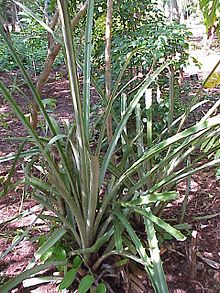Bromelia
| Bromelia | |
|---|---|

| |
| Bromelia karatas | |
| Scientific classification | |
| Kingdom: | Plantae |
| Clade: | Tracheophytes |
| Clade: | Angiosperms |
| Clade: | Monocots |
| Clade: | Commelinids |
| Order: | Poales |
| Family: | Bromeliaceae |
| Subfamily: | Bromelioideae |
| Genus: | Bromelia L. |
| Synonyms[1] | |
| |
Bromelia is the type genus of the plant family Bromeliaceae, subfamily Bromelioideae. Bromelia species are widespread across much of Latin America and the West Indies,[1] and are characterized by flowers with a deeply cleft calyx. The genus is named after the Swedish medical doctor and botanist Olof Bromelius (1639-1705).
The type species is B. karatas.
Species[]
- Brongniart ex Houllet - French Guiana
- H. St. John - from Sinaloa south to Nicaragua
- L.B. Smith - Guyana and Suriname
- Bromelia antiacantha Bertoloni - Brazil, Uruguay
- P.J.Braun, Esteves & Scharf - Maranhão
- Ule - Bahia
- P.L. Ibisch & R. Vásquez - Bolivia
- L.B. Smith - Ceará
- Bromelia balansae Mez - Brazil, Colombia, Bolivia, Argentina, Paraguay
- Bromelia binotii E. Morren ex Mez - Espírito Santo
- Leme & E. Esteves - Tocantins
- P.J.Braun, Esteves & Scharf - Bahia
- Bromelia chrysantha Jacquin - Venezuela, Colombia, Trinidad & Tobago
- Esteves, Hofacker & Scharf - Mato Grosso
- L.B. Smith - Maranhão
- L.B. Smith - Amazonas of Brazil
- Leme - Piauí
- Mez - Goiás
- I. Ramírez & Carnevali - Aragua of Veenzuela
- L.B. Smith - Suriname
- L.B. Smith - Colombia
- Mez - Minas Gerais and Goiás
- Bromelia goeldiana L.B. Smith - Venezuela and Brazil
- Mez - Goiás
- Mez - Brazil
- L.B. Smith & Gouda - French Guiana
- E. Pereira & Moutinho
- var. funchiana E. Pereira & Leme -Bahia
- var. gurkeniana - Pará
- Bromelia hemisphaerica Lam. - from Guanajuato south to Panama
- Bromelia hieronymi Mez - Bolivia, Paraguay, Argentina
- Rauh - Mato Grosso
- Bromelia humilis Jacquin - Venezuela, Trinidad & Tobago, Netherlands Antilles
- R. Vásquez & P.L. Ibisch - Bolivia
- L.B. Smith - Brazil
- L.B. Smith - Goiás
- Bromelia karatas Linnaeus - West Indies; Latin America from San Luis Potosí + Sinaloa south to Brazil
- Bromelia laciniosa Martius ex Schultes f. - Brazil + Argentina
- Bromelia lagopus Mez - Brazil
- (E. Morren) Mez - Pará
- Leme & E. Esteves - Bahia
- L.B. Smith - Goiás
- Esteves, Hofacker & Scharf - Goiás
- Leme & E. Esteves - Goiás
- (Regel) Mez - northern Brazil
- (André) André ex Mez - Colombia
- L.B. Smith - Pará
- Bromelia palmeri Mez - from Colima south to Oaxaca
- Bromelia pinguin Linnaeus - West Indies; from Mexico to Ecuador and Suriname; naturalized in Florida
- Mez - Peru
- (Baker) L.B. Smith - described 1889; origin unknown; probably extinct
- Bromelia regnellii Mez - Brazil
- Mez - Goiás
- L.B. Smith - Rondônia
- Bromelia scarlatina (hortus ex Hérincq) E. Morren - Ecuador + Brazil
- Bromelia serra Grisebach - Brazil, French Guiana, Bolivia, Paraguay, Argentina
- Mez - Jamaica
- Bromelia sylvicola S. Moore - Mato Grosso
- Ule - Peru
- Mez - Colombia
- Bromelia tubulosa L.B. Smith - Venezuela + Brazil
- Bromelia unaensis Leme & Scharf - Bahia
- Bromelia urbaniana (Mez) L.B.Sm. - Paraguay + Argentina
- Bromelia villosa Mez - Bolivia + Brazil
| Wikimedia Commons has media related to Bromelia. |
Cultivation and uses[]
The resistant fiber obtained from B. serra and B. hieronymi, both known as chaguar, is an essential component of the economy of the Wichí tribe in the semi-arid Gran Chaco region of Argentina. An 1841 publication described the fiber of silk grass () as "equal in durability to our best bowstrings."[2]
References[]
- ^ a b Kew World Checklist of Selected Plant Families
- ^ Sir Robert Hermann Schomburgk; Sir William Jardine; Andrew Crichton (1841). The Natural History of the Fishes of Guiana. W. H. Lizars. p. 102.
External links[]
Categories:
- Bromelia
- Bromeliaceae genera
- Bromelioideae stubs